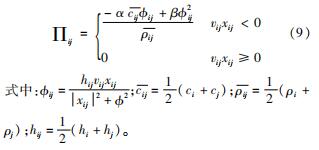基金项目:装备重大基础研究项目群资助项目
作者简介:张轩(2000—),男,硕士,研究领域为液体晃动与流固耦合。
通信作者:徐自力(1967—)男,博士,教授,研究领域为动力与推进装备结构强度与振动。
1.西安交通大学 航天航空学院 复杂服役环境重大装备结构强度与寿命全国重点实验室,陕西 西安 710049; 2.西安航天动力研究所 航天液体动力全国重点实验室,陕西 西安 710100
1. State Key Laboratory for Strength and Vibration of Mechanical Structures,School of Aerospace Engineering, Xi'an Jiaotong University, Xi'an 710049, China; 2.National Key Laboratory of Aerospace Liquid Propulsion,Xi'an Aerospace Propulsion Institute, Xi'an 710100, China
propellant tank; SPH method; half-sine impact; fluid-solid interaction; dynamic analysis
DOI: 10.3969/j.issn.1672-9374.2024.03.003
推进剂贮箱是航天器动力系统的重要组成部分,在航天器的运输、飞行过程中会受到恶劣力学环境载荷作用。冲击载荷作为一种典型的力学环境载荷,具有大幅值、高瞬态性的特点,作用在充液贮箱时会引发短暂而剧烈的流固耦合振动,严重时可能会为整个系统带来结构破坏或控制失效的风险[1-2]。然而,目前针对冲击载荷下,贮箱流固耦合响应及振动机理的研究较少。因此,使用数值方法结合实验研究,准确预示冲击载荷作用下贮箱结构在耦合振动中的响应,解释充液贮箱的流固耦合振动机理,具有重要意义。
流固耦合问题的主要研究方法有理论分析、实验研究和数值仿真这3种方法[3]。充液容器中的液体晃动的理论分析模型主要为线性势流模型。Abramson[4]首先对规则容器内的液体小幅晃动进行了建模。Isaacson等[5]研究了简谐与随机激励下任意截面的柱形贮箱的晃动特性。Gavrilyuk等[6]在2006年使用渐进模态法提出了带有环形挡板的圆柱贮箱中液体晃动的理论解。但是,理论分析模型仅适用于简单容器的有限幅晃动问题,对于复杂贮箱中的非线性晃动问题,仍需借助实验或数值方法进行研究[3]。
利用实验研究充液容器的液体晃动特性是一种实际可靠的方法。吴文军等[7]在2021年开展了球形贮箱的晃动实验,测量了贮箱内液体产生的非平衡力和力矩。王为等[8]开展实验,研究了半球形容器中液体自由晃动的非线性现象。Green等[9]在2007年使用全尺寸航天器隔膜贮箱进行了实验,分析了飞行状态载荷下的贮箱晃动特性。
随着计算机的发展和计算力学的进步,使用数值仿真计算火箭发动机系统流固耦合响应逐渐成为一种高效而准确的分析途径[10-11]。流体响应方面,岳宝增等[12]使用任意欧拉-拉格朗日(ALE)方法对球形贮箱中液体大幅度晃动中的晃动力和波高问题进行了研究。周倩倩等[13]使用流体体积(VOF)方法计算了圆柱形贮箱大幅晃动过程中自由液面与液体质心变化情况。袁雄飞[14]根据真实工作载荷,利用VOF方法分析了不同油箱和燃油参数对液体晃动的影响。马骏骁等[15]使用光滑粒子流体动力学(SPH)方法对球形贮箱的晃动问题进行了分析,得到了运动参数对晃动的影响规律。Rudman等[16]使用二维SPH方法,分析了高低液位的两种液化天然气(LNG)贮箱内液体的晃动响应。
结构响应方面,Yang等[17]通过实验与基于ALE的双向流固耦合模型,分析了直升机油箱跌落过程中不同参数对失效行为的影响。杨尚霖等[18]针对机动行为下的飞机油箱,采用VOF方法联合结构有限元方法,计算了燃油的形态变化与油箱壳体结构的应力响应等结果,但未考虑结构变形对流体响应的影响。赵懿[19]使用SPH方法分析了大型LNG储罐在地震环境下的动响应,研究了充液量、场地效应等参数的影响。
总结文献可知,目前已有较多研究采用流固耦合方法分析充液容器响应,但使用双向耦合进行结构响应的研究较少。由于冲击载荷会使贮箱结构产生较大位移,而单向耦合无法考虑结构位移对流场的影响,因此需要使用双向流固耦合方法进行贮箱的冲击响应分析[20]。本文采用SPH方法与结构有限元方法组成的双向流固耦合方法,分析了姿轨控贮箱在冲击载荷下的加速度响应结果,并与实验结果进行了对比验证。总结了不同载荷量级、不同充液高度比对加速度响应的影响,对偏差波动的产生机理进行了分析,为研究姿轨控贮箱的冲击响应提供参考。
由于冲击载荷作用下贮箱结构会发生较大刚体位移,考虑双向耦合时,依赖于网格的流场分析方法需要大量动网格操作来保证流固耦合面之间不发生分离或侵入,计算稳定性和效率均无法保证。针对上述问题,本文使用不依赖于网格的SPH方法,避免了动网格过程中的网格畸变问题[21]。
在贮箱流场空间Ω内,任意的连续函数都可以用以下的积分形式表示。
f(xi)=∫Ω f(xj)δ(xi-xj)dxj(1)
式中:f(xi)为坐标向量x的函数; δ(xi-xj)为狄拉克函数,其定义为

由于δ(xi-xj)在xi=xj处不连续,不适合计算机计算,构造一种光滑核函数W(xi-xj,h)代替δ(xi-xj),如图1所示。则任意连续函数f(xi)可以近似表示为

将流场Ω离散为有限个粒子后,如图2所示,式(3)中的积分运算被离散为求和运算,即

式中Wij=W(xi-xj,h)。
粒子i处的空间导数的近似值经推导可以表达为

由此,SPH方法可以将贮箱流场中的任意连续函数的运算近似转化为对有限个简单核函数的运算,降低了运算难度。
将流体的控制方程,即Navier-Stokes方程组使用核近似和粒子近似方法离散后,质量守恒方程可以表示为

动量守恒方程可表示为

能量守恒方程可表示为

式中:vij=vi-vj。
SPH方法将流体的控制方程离散为求和形式的方程组,每个时间步中仅需对所有粒子遍历求解,即可得到内部流场的整场响应。
分析液体晃动响应时,需要考虑黏性,SPH方法采用最广泛的人工黏性是Monaghan形式,表达式为

本文试验中使用的贮箱整体呈椭球形、中间环绕着6个耳片,均由钛合金制成。实验时,通过贮箱耳片将贮箱与实验台上的夹具相连,使用与液体燃料性质相似的液态水作为填充液体。实验贮箱以及实验系统的组成示意图如图3所示。
(a)实验贮箱
(b)实验系统
实验在贮箱支耳处施加沿着贮箱长轴方向的半正弦加速度冲击载荷,峰值为30g,如图4所示。
实验使用的电磁振动台是通过调整输出力来实现对贮箱控制点加速度的间接控制。正式实验前需要进行多次-21 dB量级下的预实验来调整实验台输出力,使得贮箱控制点的加速度曲线满足实验加速度载荷的要求,随后将输出力线性放大,用于正式实验。实验的流程如图5所示。载荷量级计算式为
n=20lg(An/A0)(10)
式中:n为载荷量级; A0为原始载荷幅值; An为目标载荷幅值。
根据实验中使用的充液贮箱,建立贮箱的几何结构,使用壳单元划分贮箱壳体与支耳,网格总数为4 405。在贮箱内部流体区域生成SPH粒子,粒子数为40 585。根据实验中夹具形状建立一个刚体的夹具结构,用于模拟实验中实验台、支撑结构与充液贮箱的相互作用。充液贮箱模型如图6所示。
实际实验中,低量级下振动台输出的力和贮箱控制点的加速度是线性对应的; 而高量级下,由于流固耦合效应,贮箱控制点加速度与实验台的输出力之间不再是线性对应,控制点的加速度曲线产生了较大的波动,使用加速度作为仿真激励已经不再准确。
由于实验时贮箱本身受到的是力不是加速度,因此,为更准确模拟实验载荷,采用“加速度-力”的两段式载荷加载流程,时间历程与实验同为0.15 s,如图7所示。首先对夹具底面施加-21 dB的加速度冲击载荷,提取夹具底面受到的支反力,其近似等效于预实验中得到的输出力,随后将支反力放大到对应量级,施加在分析模型上,计算响应结果。
姿轨控贮箱通过支耳与其余结构连接,分析支耳处的加速度响应可以用于表征贮箱对其他部件的影响。-21 dB量级预实验中、0 dB量级正式实验中以及0 dB量级仿真中贮箱支耳处的加速度响应结果对比如图8所示。
从图8中可以看出,-21 dB预实验的支耳加速度曲线平滑。在0 dB正式实验中,加速度响应前0.06 s内出现了幅值较小、频率较低的波动; 在0.06 s后出现了幅值较大、频率较高的剧烈波动,并且最大的偏差峰值为23.73g。
观察仿真结果与实验结果可知:数值分析得到的曲线在0.06 s后同样出现了幅值较大、频率较高的剧烈波动,与实验结果较为相似; 仿真结果中最大偏差值为24.40g,相比实验结果的误差仅有2.78%。这表明使用SPH方法建立的分析模型配合原实验设计的加载流程可以很好地还原实验中的加速度响应。
计算并对比不同载荷量级、不同充液高度比下的贮箱响应,总结不同工况对加速度响应的影响,最后研究贮箱结构与内部流体的运动趋势,分析加速度波动的产生原因。
为探究不同载荷量级对充液贮箱响应结果的影响,分别将支反力放大到-9 dB、-6 dB、-3 dB与0 dB量级,计算贮箱支耳处响应结果,如图9所示。
从图9中可以看出:载荷量级小于-6 dB时,响应曲线与载荷曲线偏差很小,没有超出容差线的范围; 载荷量级为-3 dB时,响应曲线出现了两个超出容差线的峰值,最大超出值为5.33g; 载荷量级达到0 dB时,偏差峰值进一步增大,最大超出值为24.40g。
总体上看,随着载荷量级从-9 dB逐渐提高到0 dB,加速度曲线的波动从无到有,偏差峰值逐渐提高。
贮箱中的液体高度在短暂的冲击载荷作用时,可以近似认为处于稳定状态。为探究不同液面高度对充液贮箱响应结果的影响,设置了液面高度与贮箱高度比为25%、50%、75%和100%的4种较为典型的充液比工况,如图 10所示。
4种工况均施加0 dB量级的载荷,得到的加速度响应曲线如图 11所示。
从图 11中可以看出:充液比在50%以下时,贮箱响应结果并没有出现明显的非线性现象; 高度比为75%时,仅有一个波动峰值超出了容差线,超出值为7.82g; 满充液时,最大超出值上升到24.40g。
总体上看,随着充液比从25%逐渐增加到100%,加速度曲线的波动从无到有,偏差峰值逐渐提高。
为了验证液体对充液贮箱的液体-结构耦合系统的影响,在贮箱两侧端点设置监测点,如图 12所示。
提取了0 dB量级的载荷下,满充液贮箱长轴两侧顶点附近的液体位移、壳体位移与Mises应力响应曲线,监测点位置如图 12所示,两点的响应曲线与贮箱加速度曲线对比如图 13所示。
从图 13中可以看出:液体与结构的运动并不同步,在壳体受到冲击载荷作用下反复运动的过程中,液体与壁面间会发生分离和碰撞。液体与壳体的位移曲线显示,在半正弦峰值过后,监测点2和监测点1附近的液体先后与壳体发生剧烈地碰撞。壳体应力曲线中,这两次冲击产生的应力远高于其余时段,表明这两次冲击对结构响应影响最大。监测点1和监测点2响应曲线与加速度曲线的对比表明两次剧烈的冲击就是贮箱加速度曲线波动发生的主要原因。
对比满充液贮箱在不同载荷量级下的液体与贮箱间的冲击情况,-9~0 dB载荷下,贮箱长轴两端点的液固速度差曲线如图 14所示。
从图 14中可以看出,随着载荷量级增加,两个监测点的液固速度差曲线的突变更加明显,并且最大值也从-9 dB下的6.91 m/s提高到0 dB下的40.02 m/s。这表明随着载荷量级增加,液体与结构冲击前的速度差会随之增加,进而导致更为剧烈的冲击,产生峰值更高的波动。
1)实验结果表明,充入大量液体的推进剂贮箱在受到高量级的冲击载荷时,贮箱支耳处的加速度响应曲线会发生剧烈波动。
2)在冲击载荷逐渐增加到-3 dB时,满充液贮箱的加速度曲线出现波动,其峰值为5.33g; 0 dB量级载荷作用下,在液位逐渐上升到75%时贮箱的加速度曲线出现波动,其峰值为7.82g。
3)0 dB量级满充液贮箱的加速度曲线波动最大,其峰值为24.40g,与对应实验结果间的误差仅为2.78%。
4)冲击过程中,贮箱中的液体与贮箱壳体的运动并不同步。二者分离后又产生的剧烈冲击是冲击后响应波动产生的原因。